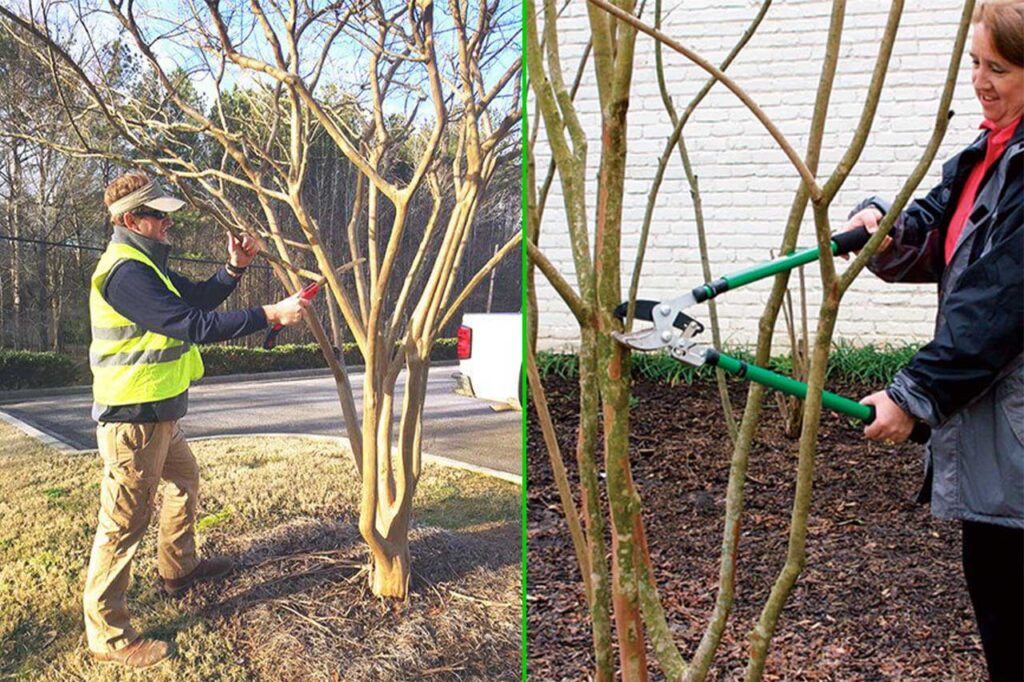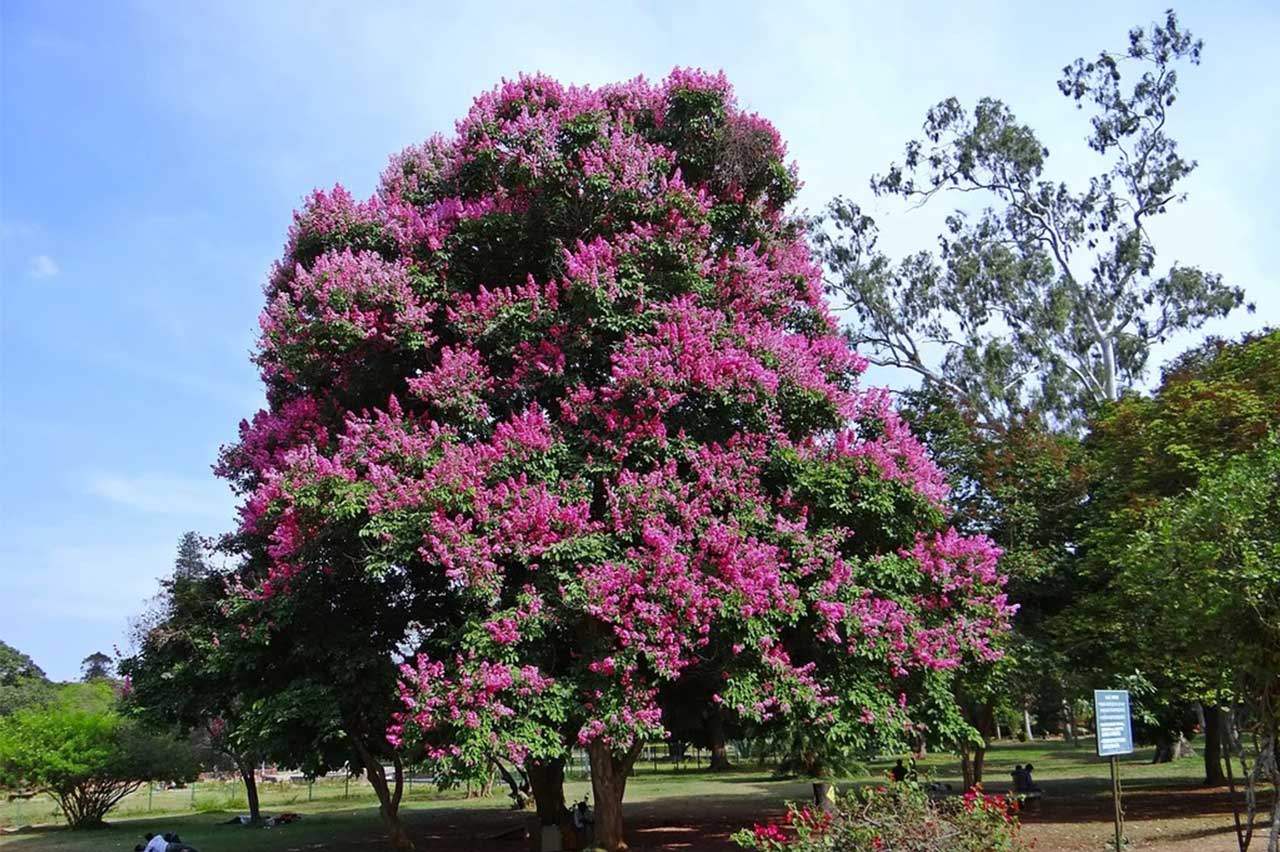Pruning is a fundamental aspect of cultivating a thriving garden, and when it comes to enhancing the beauty of outdoor spaces, knowing how to prune crepe myrtles is a horticultural skill worth mastering. In this guide, we will delve into the art and science of prune crepe myrtles, exploring the best practices, optimal timing, and essential techniques to ensure these botanical gems flourish in all their splendor. Join me as we embark on a journey to unlock the secrets of successful prune crepe myrtles, transforming your garden into a haven of natural elegance and vitality.
Understanding Crepe Myrtles
To embark on a journey of effective crepe myrtle pruning, it’s essential to grasp the intricacies of these botanical wonders. Crepe myrtles, scientifically known as Lagerstroemia, are deciduous trees or shrubs celebrated for their stunning summer blossoms and distinctive exfoliating bark.
A. Basic Characteristics and Growth Patterns
Crepe myrtles showcase a range of sizes, from compact shrubs to tall trees, offering versatility in garden landscapes. With glossy green leaves and vibrant, crinkled flowers that resemble crepe paper, these plants add a touch of elegance to any outdoor space. Understanding the growth habits of crepe myrtles is crucial for tailoring pruning practices to their specific needs.
B. Different Varieties of Crepe Myrtles
The crepe myrtle family boasts an array of cultivars, each with its unique features, such as flower color, size, and bark texture. Varieties like Natchez, Dynamite, and Muskogee bring diversity to gardens, and being familiar with the specific traits of your crepe myrtle aids in making informed pruning decisions.
Whether you have a small Lagerstroemia indica or a towering Lagerstroemia fauriei, recognizing the distinctions among crepe myrtle varieties allows for a more personalized and effective approach to pruning, ensuring the optimal expression of their natural beauty. Stay tuned as we delve deeper into the art of pruning these enchanting botanical specimens.
Why Prune Crepe Myrtles?
In the intricate dance of horticulture, pruning emerges as a choreography of care, and when it comes to crepe myrtles, the choreography is particularly nuanced. Pruning is not a mere aesthetic endeavor; it is a fundamental act of cultivation that profoundly influences the health, vigor, and visual appeal of these splendid specimens.
A. Promoting Healthy Growth
Pruning serves as a strategic conductor, guiding the growth trajectory of crepe myrtles. By removing dead or diseased branches, we eliminate potential breeding grounds for pests and diseases, fostering an environment conducive to robust vitality. Proper pruning encourages the development of a strong and well-structured framework, preventing overcrowding and ensuring ample sunlight penetration—a prerequisite for photosynthesis and overall plant well-being.
B. Enhancing Flowering and Overall Aesthetics
One of the hallmark attractions of crepe myrtles lies in their resplendent floral displays. Pruning plays a pivotal role in amplifying this visual spectacle. By selectively trimming branches, we stimulate the production of new growth and flowers. The artistry of pruning unveils the inherent beauty of the crepe myrtle, creating a harmonious balance between form and function.
C. Removing Dead or Diseased Branches
Just as a painter meticulously refines each stroke, a gardener’s hand must be equally discerning. Pruning away dead or diseased branches is akin to an artist erasing imperfections, allowing the crepe myrtle to channel its energy into areas that contribute to its overall splendor. This targeted removal not only safeguards the tree from potential threats but also elevates its aesthetic allure.
The Best Time to Prune Crepe Myrtles
Timing is everything in the world of gardening, and pruning crepe myrtles is no exception. To unlock the full potential of these botanical beauties, understanding the rhythm of the seasons is key. Let’s explore the optimal moments to pick up those pruning shears and sculpt your crepe myrtles with finesse.
A. Overview of Pruning Seasons
Pruning, when done thoughtfully, can be a rejuvenating symphony for crepe myrtles. However, choosing the right season is crucial for ensuring the tree’s health and vitality. There are two primary seasons to consider: late winter and early spring. During this dormant period, crepe myrtles are less susceptible to stress, allowing for a seamless transition into the growing season.
B. Benefits of Pruning in Late Winter or Early Spring
- Stimulating New Growth: Pruning during late winter or early spring prompts the crepe myrtle to channel its energy into producing fresh, vigorous growth. This burst of new growth contributes to a fuller canopy and abundant blossoms during the flowering season.
- Mitigating Winter Damage: Trimming away dead or damaged branches incurred during the winter months is particularly effective during late winter pruning. This not only enhances the tree’s overall appearance but also eliminates potential entry points for pests and diseases.
- Avoiding Disruption to Flowering: Pruning before the emergence of new buds allows for the removal of unwanted branches without compromising the upcoming floral display. This strategic timing ensures that the tree’s natural beauty remains uninterrupted.
C. Caution Against Late Summer/Fall Pruning
While the late winter and early spring are optimal pruning windows, it’s crucial to exercise caution during late summer and fall. Pruning during these periods may stimulate new growth that won’t have sufficient time to harden before winter, potentially exposing the tree to cold damage.
How to Prune Crepe Myrtles
Pruning crepe myrtles is an art form that, when mastered, can elevate these majestic trees to new heights of beauty and vitality. To embark on this horticultural journey, let’s delve into the practicalities of how to prune crepe myrtles with precision and finesse.
A. Tools Needed for Pruning
- Pruning Shears: Ideal for smaller branches and delicate precision cuts.
- Loppers: Designed for thicker branches that require a bit more leverage.
- Pruning Saw: Essential for tackling larger limbs with ease.
- Hand Pruners: Perfect for light pruning and shaping.
Choosing the right tools ensures a clean and effective pruning process, minimizing stress on both the tree and the gardener.
B. Step-by-Step Guide to Proper Pruning Techniques
- Remove Dead or Diseased Wood: Start by identifying and removing any dead or diseased branches. This not only improves the overall health of the tree but also prevents the spread of pathogens.
- Thinning Out Crossing Branches: Identify branches that cross or rub against each other, as these can lead to wounds and increased vulnerability to diseases. Remove the weaker of the two branches to allow for better air circulation and light penetration.
- Selective Branch Removal: Choose branches strategically for removal to enhance the tree’s natural form. Focus on creating an open canopy that allows sunlight to reach the inner branches.
- Maintain Natural Shape: Crepe myrtles have a distinctive natural shape, and pruning should complement rather than alter it. Avoid excessive shaping that may compromise the tree’s integrity.
- Control Height: If necessary, prune for height control, especially if your crepe myrtle is near structures or power lines. However, avoid “topping” or indiscriminate cutting of the upper branches, as this can lead to an unnatural and unsightly appearance.
C. Common Mistakes to Avoid
- Over-Pruning (Crape Murder): Drastic or excessive pruning, often referred to as “crape murder,” can harm the tree’s health and aesthetics. Avoid removing more than one-third of the canopy in a single pruning session.
- Pruning Too Late in the Season: Late summer and fall pruning can stimulate new growth that may not have enough time to harden before winter, making the tree susceptible to cold damage.

Special Considerations
Pruning crepe myrtles involves a nuanced approach, and considering special circumstances can make a significant difference in the health and aesthetics of these remarkable trees. In this section, we’ll explore considerations for multi-trunked crepe myrtles and the distinctive needs of both young and mature specimens.
A. Addressing Multi-Trunked Crepe Myrtles
- Maintaining Natural Form: Multi-trunked crepe myrtles often exhibit a graceful, natural form. When pruning, aim to enhance this unique structure rather than imposing an artificial shape. Remove any competing or crowded trunks to maintain a well-balanced appearance.
- Thinning Out for Airflow: Due to the denser nature of multi-trunked specimens, it’s crucial to thin out branches strategically to promote better airflow. This helps prevent issues like powdery mildew and improves overall tree health.
B. Pruning Young Versus Mature Trees
- Young Trees (1-3 Years): Focus on establishing a strong framework by removing any weak or competing branches. Encourage a central leader for a well-balanced structure. Light pruning in the early years sets the stage for a healthy and shapely mature crepe myrtle.
- Mature Trees (4 Years and Older): By this stage, the emphasis shifts to maintaining the tree’s natural form. Remove dead or diseased wood, thin out crowded branches, and selectively prune for shape. Avoid heavy pruning, as mature crepe myrtles benefit more from thoughtful maintenance than drastic alterations.
Common Myths about Crepe Myrtle Pruning
As with any beloved plant species, crepe myrtles are surrounded by myths and misconceptions, especially when it comes to pruning. Let’s debunk some of the common myths that may have taken root in the gardening community, ensuring that your crepe myrtles receive the care they truly deserve.
A. Myth: “Crape Murder” is Beneficial
One of the most persistent and damaging myths is the idea that severe pruning, often referred to as “crape murder,” is beneficial for crepe myrtles. In reality, this practice can lead to weak regrowth, make the tree more susceptible to diseases, and result in an unnatural and unsightly appearance.
B. Myth: “The More You Prune, the More Flowers You Get”
While pruning does stimulate new growth and flowering, excessive pruning doesn’t necessarily translate to more blooms. Crepe myrtles have their natural growth patterns, and indiscriminate cutting can disrupt their ability to produce flowers. Prune thoughtfully to maintain a healthy balance.
C. Myth: “Crepe Myrtles Should Be Topped Every Year”
Topping, or cutting off the upper branches, is a harmful practice that disrupts the natural shape of the tree and promotes weak, unsightly regrowth. Crepe myrtles thrive when their natural form is preserved, and topping should be avoided at all costs.
D. Myth: “Late Summer Pruning is Ideal”
Pruning during late summer or fall is not recommended for crepe myrtles. The stimulation of new growth during this period may not have sufficient time to harden before winter, exposing the tree to potential cold damage. Stick to the recommended late winter or early spring pruning for optimal results.
Conclusion
In the intricate tapestry of garden care, the act of pruning crepe myrtles emerges as both an art and a science. As we conclude our journey through the nuances of this essential horticultural practice, let’s recap the key insights that will empower you to cultivate thriving, resplendent crepe myrtles in your garden.
- Timing is Crucial: Pruning during late winter or early spring is ideal, allowing for the stimulation of new growth without exposing the tree to cold damage. Avoid the temptation to prune late in the season.
- Precision is Key: Choose the right tools for the job and employ a thoughtful approach to pruning. Removing dead or diseased wood, thinning out branches, and maintaining the natural form contribute to a healthier and more aesthetically pleasing crepe myrtle.
- Beware of Myths: Dispelling common myths, such as the notion of “crape murder” being beneficial or the belief that topping promotes more flowers, is essential. Embrace a holistic and informed approach to crepe myrtle care.
- Consider Special Cases: Multi-trunked crepe myrtles require a different strategy, focusing on maintaining their natural form and improving airflow. Tailor your pruning approach based on whether the tree is young and establishing its structure or mature and requiring maintenance.
As you embark on your crepe myrtle pruning endeavors, remember that each snip of the shears contributes to the overall health and beauty of these magnificent trees. With thoughtful care and a keen understanding of their unique needs, your garden can flourish with the vibrant colors and graceful forms that crepe myrtles are known for. Happy pruning!

Leave a Reply